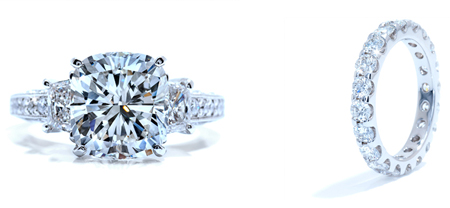White Gold vs Platinum
Gold:
For thousands of years jewelers have used Gold to create ‘fine jewelry’ for pharaohs, kings and those wishing to express love, appreciation and commitment.
Pure fine gold [24 karat] is intrinsically soft and impractical for jewelry items to be worn regularly. To overcome this, jewelers over time perfected ‘gold based’ metals with the hardness characteristics necessary to prevent a piece from bending easily, yet malleable enough for craftsmen to create jewelry that can be passed on for generations.
14k and 18k gold is created by blending other metals [alloy] to the fine gold:
18k gold = 18/24ths [75%] fine gold; 14k gold is 14/24ths [58.3%] fine gold.
White gold or rose gold is produced by modifying the alloy to include more silver or palladium [for white gold] or more copper [for rose gold].
White gold is often plated with Rhodium [a costly naturally white metal] in order to make the white gold ‘extra white’. With regular wear Rhodium plating tends to come off, however is easily replaced for a modest charge.
Platinum:
Platinum is an intrinsically white hypoallergenic metal.
Like fine gold, pure platinum is soft and requires a small percentage of alloy to create a ‘Platinum based’ metal strong enough for practical use yet pliable for craftsmen.
Most platinum based metal is 90-95% pure platinum with the balance a blend of different alloys.
Platinum is significantly more dense than 14k or 18k gold and the identical piece in platinum will weigh 60% to 80% more than 14k or 18k gold.
The additional density [weight] of platinum combined with the higher value of Platinum results in a higher cost for the same design.
Depending upon the weight of a ring there would be an additional cost for Platinum over 14k or 18k gold somewhere in the range of $300 to $800.

